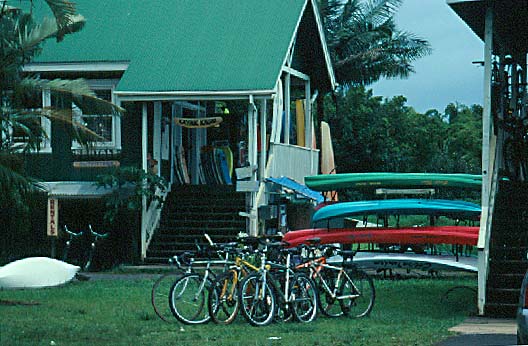 |
 |
 |
|||||||||
|
|
|
|
|
|
|
|
|
||||
|
|
|||||||||||
|
|||||||||||
|
|
Underlying this changing population is the land, much of it controlled by Limahuli Gardens and the State Parks division and therefore largely undeveloped or underused. This situation provides the opportunity to reinvest the land with a system of community oversight and cooperative management with the State, in a form reminiscent of the original ahupua‘a notion. "With the State Park system owning the makai or ocean portion of Limahuli valley," Carlos explains, "and with Chipper as the head of Limahuli Gardens--which ostensibly owns all of Limahuli valley--what we had hoped to do was to form an organization and weld together all of this land from the mountain top, all the way to the ocean, by linking the State Park to Limahuli, in spirit if in no other way. "The State Park, because it is a State park, doesn't have any private ownership anymore. The State Park purchased the land, using federal funds which were earmarked for recreation. They were mandated for a park that fit within the constraints of what was considered "recreation." The people who run the State Parks, they tend to be Mainland-trained, so they created a park that has bicycle paths, and similar kinds of things you would see in a recreational park that would satisfy Mainland views of recreation. But in doing so, they largely neglected all the cultural assets that are part of this area.
|
||
|
|
||
"The community got together and said 'hey, we don't like that, we feel you should recognize and utilize, and restore, and make the park be something that highlights or at least features the cultural assets and features that are part of this area.' So now we have something of a compromise plan that State Parks came up with, to address the cultural areas. There are still pedestrian and bicycle paths, but they are no longer go over the lo‘i complex that is there, all the stone walls (map). "However, the State Government at this time does not have the personnel or the funds to run this park properly. If you went down to where the bathroom is at Ke‘e Beach, there are many portable toilets and the actual bathroom is a shambles. There is really nobody here taking care of the park. What is happening within the park land, is it's just being overgrown by a jungle. And yet we still get a constant flow of visitors here all the time, and the number of users is growing every year. So they need people down here to keep an eye on the place, to help them restore it, to help them prepare the park for users, and all that.
|
||
|
|
||
"The reefs and the ocean outside of the park, we're also hoping to get them to come under our jurisdiction, to be managed through a traditional reef or ocean management scheme or process that we need to develop. Because as it is now, anybody can go fishing here any time they want. And the resources of the reef are being depleted. Because people come from all parts of the island, as well as other islands, and they're just go out there thinking 'oh, open range, help yourself.' Which can work now, because the population is low. "But as the population grows, even now there are conflicts among the fishermen--the local fishermen versus the outside fishermen. So we're going to have to come up with some kind of a plan that will be beneficial for the area. This is all long-range kinds of things we see happening in the future. Right now, we have one little taro garden growing, and that's our foothold. To be able to become the stewards of this place, we have to develop a relationship with the State organizations and people who are involved." Organizing in such a way as to manage and achieve all the goals set forth requires a new sense of community. On the next page, Carlos explains the new Hui that has come into being at Ha‘ena.
|
||
|
|
||
| |
| |
|
|
 |
| Ha'ena Home | Map Library | Site Map | Hawaiian Islands Home | Pacific Worlds Home |

|
|||
| Copyright 2001 Pacific Worlds & Associates • Usage Policy • Webmaster |
|||




